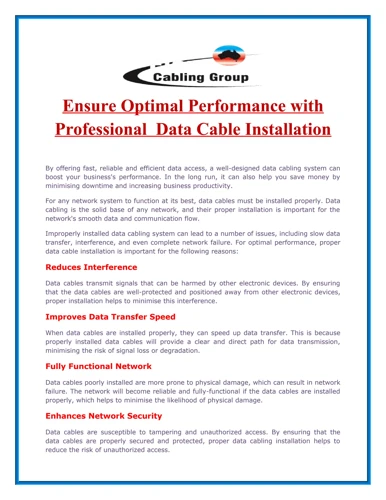Video surveillance systems have become an essential part of security measures for businesses, organizations, and even residential properties. These systems provide a means of monitoring activities, deterring criminal behavior, and providing evidence in case of incidents. However, one aspect that is often overlooked but crucial to the effectiveness of video surveillance is cabling. The quality of cabling used in a video surveillance system can directly impact its performance and reliability. In this article, we will explore the importance of cabling in video surveillance systems and why it is essential to invest in high-quality cabling solutions.
The Role of Cabling in Video Surveillance

Cabling plays a critical role in video surveillance systems as it is the backbone that connects all the components together. The cameras, recorders, monitors, and other devices in a video surveillance system rely on cables to transmit power and data signals. The quality of the cabling can affect the overall performance of the system in several ways.
1. Signal Quality
The quality of the cabling directly impacts the signal transmission between the cameras and the recording devices. Poor-quality cables can result in signal degradation, leading to poor video quality, lost frames, and even complete signal loss. High-quality cabling ensures a stable and reliable connection, allowing for clear and uninterrupted video footage.
2. Distance Limitations
Different types of cabling have limitations when it comes to the distance over which they can transmit signals effectively. For longer distances, such as in large industrial facilities or expansive outdoor areas, specialized cabling solutions are required to ensure that the video surveillance system covers the entire area without any signal loss. Investing in cabling that is designed for long-distance transmission can help optimize the coverage of the surveillance system.
3. Power Supply
In addition to transmitting data signals, cabling also carries power to the cameras and other devices in the surveillance system. Power over Ethernet (PoE) cabling is commonly used in modern video surveillance systems as it allows for both data and power transmission over a single cable. Using high-quality PoE cabling ensures a stable power supply to the cameras, reducing the risk of power interruptions that could compromise the security of the premises.
Benefits of High-Quality Cabling

Investing in high-quality cabling for video surveillance systems offers several benefits that directly impact the performance and reliability of the system.
1. Enhanced Reliability
High-quality cabling is more durable and less prone to damage, ensuring a reliable connection between the components of the surveillance system. This reliability is crucial for continuous monitoring and recording of video footage without any interruptions due to cable failures.
2. Improved Video Quality
The use of high-quality cabling results in better signal transmission, leading to improved video quality with sharp images and accurate colors. Clear and high-resolution video footage is essential for effective surveillance and detailed identification of individuals or events captured on camera.
3. Long-Term Cost Savings
While high-quality cabling may have a higher upfront cost compared to standard cabling options, it offers long-term cost savings by reducing the need for frequent replacements and repairs. Investing in durable cabling solutions ensures a longer lifespan for the surveillance system, minimizing maintenance costs over time.
4. Scalability and Future-Proofing
High-quality cabling allows for easier scalability of the video surveillance system as new cameras or devices can be added without the need to upgrade the cabling infrastructure. This future-proofing ensures that the surveillance system can adapt to changing security needs and technological advancements without major reconfigurations.
Choosing the Right Cabling Solution

When selecting cabling for a video surveillance system, there are several factors to consider to ensure optimal performance and reliability.
1. Cable Type
The type of cable used in the surveillance system depends on the specific requirements of the installation. Coaxial cables, twisted pair cables, and fiber optic cables are common options, each with its own advantages in terms of signal transmission, distance capabilities, and environmental suitability. Consulting with a professional installer can help determine the most suitable cable type for the project.
2. Cable Quality
Opting for high-quality cables from reputable manufacturers is essential to ensure the reliability and performance of the video surveillance system. Cheap or substandard cables may save on costs initially but can lead to issues such as signal loss, interference, and frequent failures, ultimately compromising the security of the premises.
3. Installation Considerations
Proper installation of cabling is as crucial as selecting the right cable type and quality. Cables should be routed strategically to avoid interference from electrical sources, minimize signal loss, and protect against physical damage. Working with experienced installers who follow best practices in cabling installation is key to maximizing the effectiveness of the surveillance system.
Looking to enhance your video surveillance system? Learn more about the importance of video storage, maximizing the lifespan of video surveillance systems, training employees on video surveillance importance, the impact of lighting on video surveillance, and troubleshooting wired video surveillance systems for a comprehensive understanding of the subject!
Conclusion

In conclusion, cabling is a critical component of video surveillance systems that should not be overlooked. Investing in high-quality cabling solutions offers numerous benefits, including enhanced reliability, improved video quality, long-term cost savings, and scalability. By choosing the right cabling solution and ensuring proper installation, businesses and organizations can create a robust surveillance system that provides effective security monitoring and peace of mind. Prioritizing cabling in video surveillance projects is an investment in the overall safety and security of the premises.







